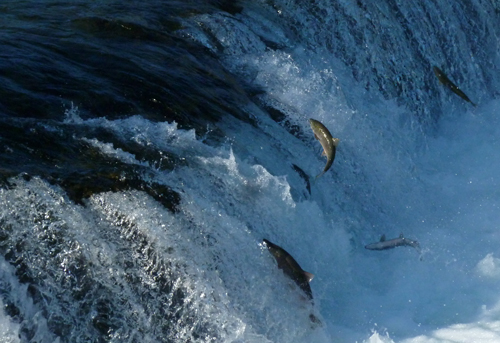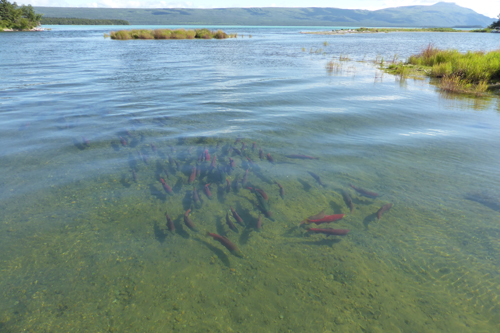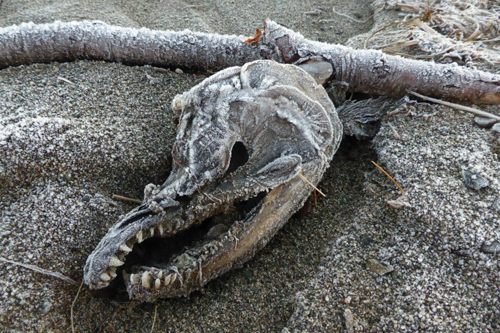
200,000 to 400,000 salmon may successfully leap Brooks Falls each year.
In winter, ice and snow cover much of Katmai’s landscape. Salmon fry bide their time waiting to become smolt and run to sea. Later in the year and soon after the smolt depart, much larger salmon are returning from the ocean. In late June, schools of silvery and energetic fish begin to pulse through the river. During August and September, the Brooks River is dotted with ruby-colored jewels digging nests and fighting for territory. Soon after, the waters of Katmai begin to quiet again. The salmon have spawned and most are dead. Eggs are quietly incubating.
These are extreme contrasts, but the Brooks River is a dynamic place. Maybe nothing else better illustrates this than the annual sockeye salmon run--a powerful example of change, adaptation, and instinct.
In the Brooks River, mature sockeye salmon are absent for most the year. The quiet of winter slowly gives way to the abundance of summer. Salmon are the foundation of this change. Typically, salmon first arrive at the mouth of the Brooks River in mid June, but they don’t start to move into the river in large numbers until late June. The peak of the sockeye salmon run in the Naknek River watershed, which the Brooks River is part of, is in early July.
During their migration, salmon don’t move into the Naknek River or Brooks River in consistent numbers. In Bristol Bay, commercial fishing will periodically intercept fish and outgoing tides will slow their entry in the Naknek River. The greatest numbers of salmon move in the Naknek River during high tides. These factors influence the relative abundance of fish in the Brooks River--few fish at Brooks Falls on some days and many fish on others. The Alaska Department of Fish and Game carefully manages the Bristol Bay sockeye salmon fishery to ensure that enough fish are allowed to escape the fishery and run up river to sustain the population.
By the end of July, most sockeye salmon in the Naknek River watershed have reached their spawning site, and very few fish can be seen at the falls. Their epic migration might be nearing the end, but they still have much work to do. The instinct to reproduce is driving them. Remarkable instincts and adaptations allow the salmon to complete this journey.
As fry and smolt, the salmon imprinted on the unique chemical signatures of the streams and lakes they reared in and passed through on their journey to the sea. On the return to their natal grounds, they follow these scents through the freshwater maze of lakes and rivers. Very few salmon will stray from this course. Almost all will return to their natal stream to spawn as adults.
When sockeye salmon return to freshwater from the sea and approach their spawning site, these formerly sleek and silvery fish morph into something very different in appearance and behavior. The red pigments in their flesh are transferred to the skin. Their bones soften, a large hump develops on their back, and their jaws and teeth elongate. Internally, the salmon are changing just as radically. Salmon stop feeding once they reenter fresh water. They absorb their scales and most of their body fat for nutrition. Each female salmon swells with about 4000 eggs. They are starving at the same time they are spawning.

Salmon will stage for weeks in the lower Brooks River and Naknek Lake before moving further into the river to spawn.
Sockeye salmon will spawn in lakes, but they usually prefer to spawn in streams where flowing water can be found even in winter. Females select spawning sites with high levels of dissolved oxygen and where their eggs will be protected from freezing. A female salmon, possessing no digging tools except her tail, will fan the gravel vigorously to winnow away mud and silt that would otherwise smother the eggs.
Females defend their nesting site from other females. Males fight with one another for access to females. By the end of the spawn, many salmon are visibly wounded from fighting and spawning. Those wounds will not heal. For salmon, this is a one way trip.
After they spawn in late summer and fall, Katmai’s sockeye salmon begin to die. Many will drift listlessly downstream in the Brooks River’s current. Bears, gulls, and trout use this time wisely to fatten on the fish before the long winter descends on the landscape. By November, almost all of the salmon have spawned and died, most of the bears have left the Brooks River to find a denning site, and the waters of the park begin to freeze under increasingly colder temperatures.

Adult salmon make a one way trip to Katmai.
For the salmon though, life continues. The adults may be gone, but millions of their eggs are incubating and will hatch in late winter. The salmon fry that hatched the year before are waiting for the spring season to undertake the dangerous migration to the ocean. The quiet of winter contrasts significantly with the abundance of summer in Katmai.
These fish have evolved specific adaptation and instincts to undertake a truly epic journey. The dynamism of Katmai is well illustrated by the annual sockeye salmon run. During the rest of the summer, watch the cam not only for the bears, but to marvel at the salmon.
